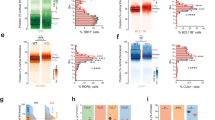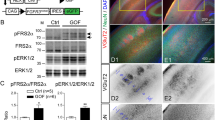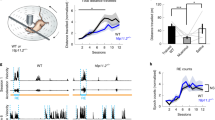Abstract
One strategy for deciphering inherited neurological disease is to examine the expression of individual genes controlling the assembly and physiology of specific cell groups within the developing mammalian central nervous system (CNS). This neurogenetic approach, using defined single-locus mutations arising on coisogeneic mouse strains, has recently been used to analyse a major class of neuronal membrane diseases involving abnormal excitability, the epilepsies, and to identify examples of hereditary variation in signalling properties at central synapses1. An interesting mutation, the Tottering (tg) gene2, causes a delayed onset, recessive neurological disorder in the mouse featuring a stereotyped triad of ataxia, intermittent myoclonus and cortical spike-wave discharges accompanied by behavioural absence seizures which resemble petit mal epilepsy3. Axon branches of the locus coeruleus, a noradrenergic brain-stem nucleus, hyperinnervate specific target regions of the tg brain4. The number of parent coerulean perikarya is unaffected, indicating a true proliferation of the terminal axonal arbor. With the exception of this unusually precise error of axonal growth, no other cytopathology has been identified in the tg brain. Here I present evidence that selective lesions of the central noradrenergic axons early in development limit the expression of the disease.
This is a preview of subscription content, access via your institution
Access options
Subscribe to this journal
Receive 51 print issues and online access
$199.00 per year
only $3.90 per issue
Buy this article
- Purchase on Springer Link
- Instant access to full article PDF
Prices may be subject to local taxes which are calculated during checkout
Similar content being viewed by others
References
Noebels, J. L. Fedn Proc. 38, 2405–2410 (1979).
Green, M. C. & Sidman, R. L. J. Hered. 53, 233–237 (1962).
Noebels, J. L. & Sidman, R. L. Science 204, 1334–1336 (1979).
Levitt, P. & Noebels, J. L. Proc. natn. Acad. Sci. U.S.A. 78, 4630–4634 (1981).
Mefford, I. N., Gilberg, M. & Barchas, J. D. Analyt. Biochem. 104, 469–472 (1980).
Sachs, Ch., Pycock, C. & Jonsson, G. Med. Biol. 52, 55–65 (1974).
Levitt, P. & Moore, R. Y. Anat. Embryol. 158, 133–150 (1980).
Schmidt, R. H., Kasik, S. A. & Bhatnagar, R. K. Brain Res. 191, 173–190 (1980).
Jacks, B. R., DeChamplain, J. & Cordeau, J.-P. Eur. J. Pharmac. 18, 353–360 (1979).
Lidov, H. G. W. & Molliver, M. E. Devl Brain. Res. 3, 81–108 (1982).
Wolfe, B. B., Minneman, K. P. & Molinoff, P. B. Brain Res. 234, 474–479 (1982).
Walton, K. G., Miller, E. & Baldessarini, R. J. Brain Res. 177, 512–522 (1979).
Amaral, D. G., Avendano, C. & Cowan, W. M. J. comp. Neurol. 194, 171–191 (1980).
Sachs, C. & Jonsson, G. in Chemical Tools in Catecholamine Research Vol. 1 (eds Jonsson, G., Malmfors, T. & Sachs, Ch.) 163–171 (North-Holland, Amsterdam, 1975).
Elias, M., Deacon, T. & Caviness, V. S., Brain Res. 233, 652–656 (1982).
Rogawski, M. A. & Aghajanian, G. K. Nature 287, 731–734 (1980).
Waterhouse, B. D., Moises, H. C. & Woodward, D. J. Expl Neurol. 69, 30–49 (1980).
Moises, H. C. & Woodward, D. J. Brain Res. 182, 327–344 (1980).
Madison, D. V. & Nicoll, R. A. Nature 299, 636–638 (1982).
Jefferys, J. G. R. & Haas, H. L. Nature 300, 448–450 (1982).
Szabadi, E. Neuropharmacology 18, 831–843 (1979).
Morrison, J. H., Molliver, M. E., Grzanna, R. & Coyle, J. T. Neuroscience 6, 139–158 (1981).
Maynert, E. W., Marczynski, T. J. & Browning, R. A. Adv. Neurol. 13, 79–147 (1975).
Corcoran, M. E. & Mason, S. T. Brain Res. 190, 473–484 (1975).
Author information
Authors and Affiliations
Rights and permissions
About this article
Cite this article
Noebels, J. A single gene error of noradrenergic axon growth synchronizes central neurones. Nature 310, 409–411 (1984). https://doi.org/10.1038/310409a0
Received:
Accepted:
Issue Date:
DOI: https://doi.org/10.1038/310409a0
This article is cited by
-
Controlling absence seizures from the cerebellar nuclei via activation of the Gq signaling pathway
Cellular and Molecular Life Sciences (2022)
-
Compromised maturation of GABAergic inhibition underlies abnormal network activity in the hippocampus of epileptic Ca2+ channel mutant mice, tottering
Pflügers Archiv - European Journal of Physiology (2015)
-
Epileptic seizures caused by inactivation of a novel gene, jerky, related to centromere binding protein–B in transgenic mice
Nature Genetics (1995)
Comments
By submitting a comment you agree to abide by our Terms and Community Guidelines. If you find something abusive or that does not comply with our terms or guidelines please flag it as inappropriate.



